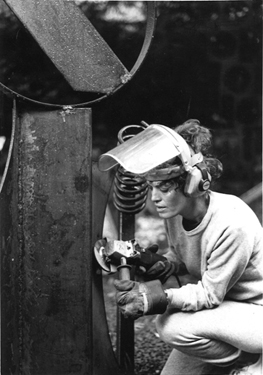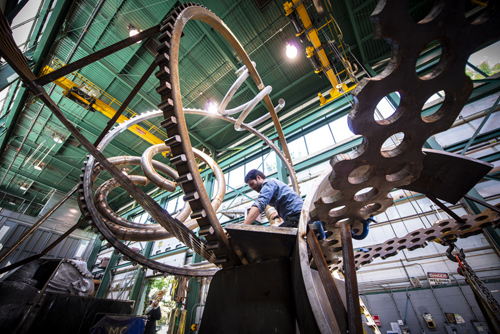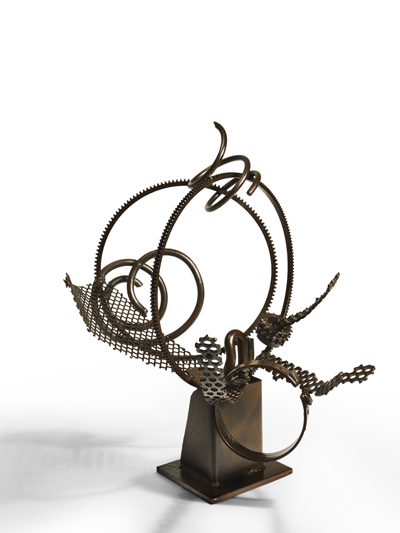Art Review: Dina Wind and Seward Johnson: Drawing in Space
By Christina Turczyn
arttimesjournal September 4, 2018
“Great images have both a history and a prehistory; they are always a blend of memory and legend, with the result that we never experience an image directly. Indeed, every great image has an unfathomable oneiric depth to which the personal past adds special color” (33).
— Gaston Bachelard, from The Poetics of Space
 1980s Dina Welding—Courtesy of the Dina Wind Art Foundation |
On July 17, I had the chance to visit Grounds for Sculpture, in Hamilton, New Jersey, to view the installation of Dina Wind's Harp of David #1. Shortly after, I was invited to tour the Seward Johnson Atelier, which currently houses The Awakening and King Lear, among hundreds of works. I am certain there is a direct experience of an image. That experience of art depends, I think, on the degree to which any viewer is willing to cast aside her interpretive lens, if only for the moment during which the piece enters the imagination's underground river. Do we journey towards our youngest selves? Toward memory or forgetting? The most compelling works take us from our desire to create context. Along the way, we shed hesitations, road maps, and clichès. I am not suggesting that powerful works of art are experienced only through feeling. I am suggesting that we meet the power of art through our most intimate selves, not necessarily translated into afterthoughts. I am thinking about art as the love that one has for someone very different from oneself: The experience of the soldier who befriends “the enemy,” which asks him to take himself apart, so as to understand. What struck me at Grounds for Sculpture is the absence of walls surrounding the site. Apparently, there was a chain-link fence at first, but the art can breathe, and the grounds foster an international community. In my mind, this is the perfect museum—while walls are being built, Grounds for Sculpture is taking them down, creating a constantly changing geography without borders, with one million wildflowers spilling out into the surrounding area.
An Art for Current Times
|
The morning was hot, the sky was clear, but storms were predicted for the afternoon. How quickly things change. I have always thought of time as a cloud blown loose from a clothesline—gesture of sky. I have never fully accepted the notion of writing as signifying absence. Sound moving through labyrinths becomes a shell, and words are altered, as well, by experience. I remember taking a walk through the grounds of the Cary Institute of Ecosystem Studies once, where a sign brought attention to the whirr and hum of natural sounds— wings, fish, cicadas. This was sound sculpture. The placement of Harp of David # 1 took into account the natural environment, as did many of Dina Wind's works, so deeply organic, vital. Tom Moran, Chief Curator at GFS, highlighted the theme of coming full circle to a small group gathered for the day, including Susan Dunsmoor, Project Coordinator. He reminded the audience that the first exhibit in the building we were in took place twenty-six years ago, when the structure had no windows, having been moved from the fairgrounds to its current location. Tom described the Grounds for Sculpture as a place where “things are changing and growing,” mentioning that the grounds offer one of the few sculpture parks next to an atelier. He added that many of the interns from the Johnson Atelier remained in the area, lending their art and expertise to the community. John Wind mentioned that Dina thought of sculpture as “drawing in space,” and that his mother had spent her youth in Israel during a politically turbulent time, so that much of her work expressed “the tension between hope and despair.” (Dina Wind, with her husband Jerry and sons John and Lee, made Philadelphia their home in 1967). For this reason, he believes that her art is “more fitting for today than ever.” I agree. The sculpture does not frame the landscape, yet invites nature through creating negative space. The spirals reach upward. The gears suggest motion with a sharp edge. In counterpoint to the spirals, the gears summon diverse concepts of time. Could the sculpture represent a return, as well as adventure?
John Wind noted that Dina worked intuitively, rarely thinking ahead. Titles were selected after the works were completed, so that the process was largely subconscious. Standing before the sculpture, I recalled Theodore Roethke's lines from “The Far Field”:
All finite things reveal infinitude.
The mountain with its singular bright shade.
Silence of water above a sunken tree;
The pure serene of memory in one man,—
A ripple widening from a single stone
Winding around the waters of the world. (97-106)
The Process
 Fabrication process of Dina Wind's Harp of David #1. The Seward Johnson Atelier. Photo courtesy of the Seward Johnson Atelier. Photographer: Ken Ek. |
Music moves in at least three dimensions. John Wind believes that the Harp of David #1 represents the “healing, soothing power of art.” As John observed, although Dina admired “beauty,” in art, that was not the central pursuit of her work. The artist's sensibility, such as that expressed in Black Islands, was often political. Standing in front of the sculpture, I wondered if the shadows resting at the base captivated visitors—in and of themselves, they approached a dreamy, abstract painting. The work expressed courage, as did an artist who felt that “a blank canvas was much less welcoming than scrap metal.” Although the artist began painting in the 1960s, she made a transition into what was still at the time the largely male-dominated culture of welding steel. Dina worked with found objects. The original gears were from bicycle chains, while the springs came from cars. The Harp of David included a train clip. When Tom Moran began the process by visiting the Wind home, he saw sculpture everywhere—indoors, as well as on the roof. In John's view, the artist was incredibly prolific, civic-minded, and “enjoyed her own work being important in the public conversation.”
The enlarged sculpture weighs 15,052 pounds. The process of restoration, stemming from the original, twenty-six-inch piece, took place between January and June of 2018. The team created a digital, scaled design, completed with a rich, russet patina.
The project was made possible by the most recent partnership between the Seward Johnson Atelier and the Dina Wind Art Foundation. The artist is represented by the Philadelphia Museum of Art, the Woodmere Art Museum, and the Pennsylvania Academy of Fine Arts, among other institutions. For almost twenty years, Dina was a member of the Nexus Gallery in Philadelphia, as well as the Veridian Gallery in New York.
Public Art
There are many walls that prevent people from experiencing art directly. Distance, real or perceived. The notion of museums as protective, enclosing spaces. Socioeconomic walls. Tom Finkelpearl's Dialogues in Public Art suggests that “meaning is constructed between the speaker and the listener, rather than simply given”(283). Visiting the Seward Johnson Atelier, I thought about how “reality” is redefined. Works that might be viewed as realistic asked me to think about virtual worlds. (The Atelier houses a digital center). What is real? Seward Johnson's art, as well, is without doubt an art for current times. Nestled in the High Bay was a jazz piano, reminiscent of Johnson's youthful sneaking into jazz studios, so that he could hear ensembles play. (I did the same). As in Dina Wind's work, existing elements are incorporated into some pieces—a group of musicians plays on real strings. King Lear and The Awakening are stored at the Atelier.
The work has a profound emotional impact. In the case of these two artists, it is like diving into a river backwards, knowing that depth will hold you up. Memories always appear larger and clearer under water—through the looking, icons become larger than life. Through the living they become detailed and accessible, tangible and human. One need only look at King Lear to feel, not only raw anguish, but also, the sea.
Seward Johnson is the artist and philanthropist whose vision brought Grounds for Sculpture into existence. Since 1992, Grounds for Sculpture has welcomed 2.1 million visitors. All over the country, poetry readings draw thousands, taking visitors away from their computers, connecting them through shared experience. I have often thought of an artistic site for peace, one in which the history of peace is embodied through music, poetry, and visual art. Peace begins with one, possibly two people at a time, in spaces where they can speak freely.
I long for the imperishable quiet at the heart of form;
I would be a stream, winding between great striated rocks in late summer;
A leaf, I would love the leaves, delighting in the redolent disorder of
this mortal life.
This ambush, this silence,
Where shadow can change into flame…
— from “The Longing,” by Theodore Roethke (43-52)
Works Cited
Bachelard, Gaston. The Poetics of Space.
Beacon Press, 1969.
Finkelpearl, Tom. Dialogues in Public Art. MIT Press, 2001.
Roethke, Theodore. The Collected Poems of Theodore Roethke. New York: Anchor
Press/Doubleday, 1975.

 Dina Wind: Harp of David #1 1985,
Dina Wind: Harp of David #1 1985,